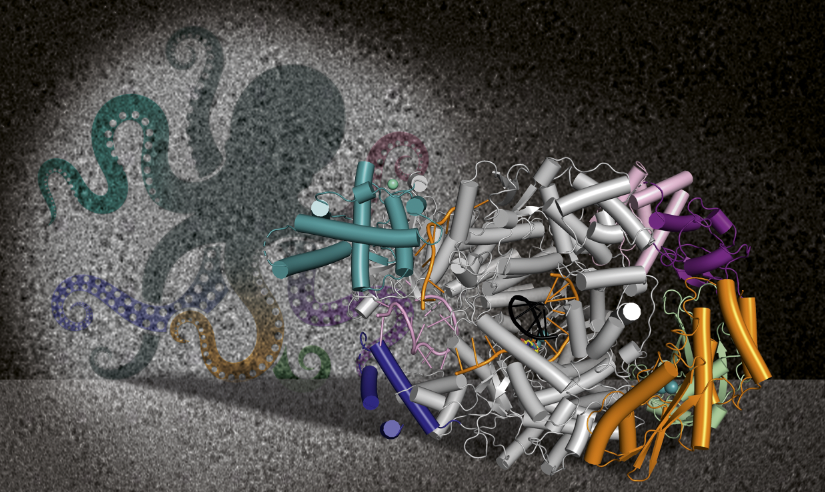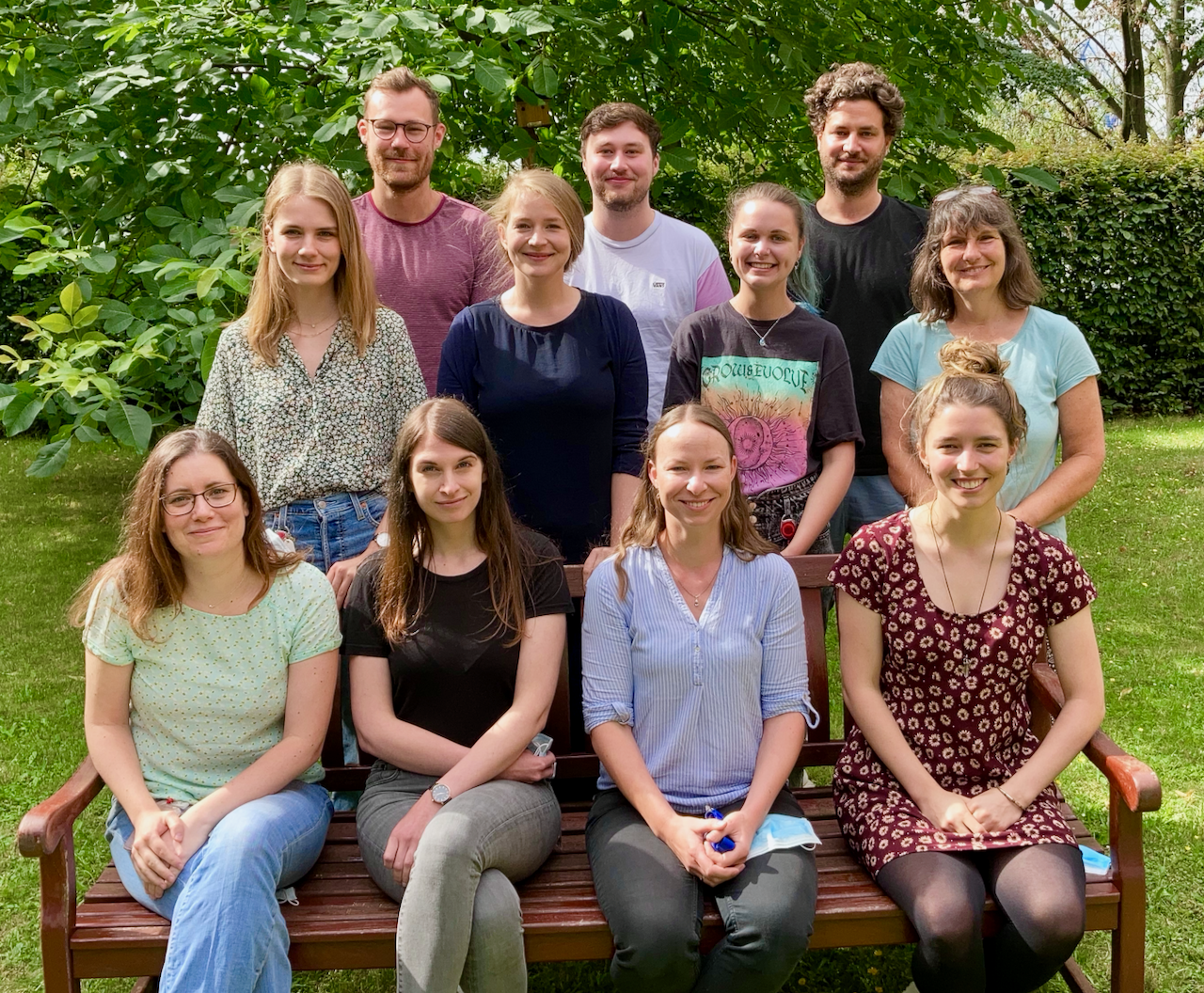Wrangling an octopus-like viral replication machine
Molekularer Oktopus im Lassavirus
Hamburg / Grenoble, 2. Dezember 2021 – Forschungsgruppen des Bernhard-Nocht-Instituts für Tropenmedizin (BNITM), des EMBL* Grenoble und des Labors vom LIV / UHH am CSSB** haben neun Strukturen eines essentiellen Lassavirus-Proteins in verschiedenen funktionellen Zuständen untersucht. Das Protein ist für die Virusvermehrung notwendig und bietet so hervorragende Angriffspunkte für antivirale Wirkstoffe. Die Ergebnisse sind jetzt in der Fachzeitschrift Nature Communications erschienen.
Lassa virus is found in West African countries and is transmitted to humans through contaminated food or household items from Mastomys mice, the natural hosts of the virus. Although many human infections with Lassa virus are asymptomatic, about one in five patients develops a severe haemorrhagic fever illness that can affect vital organs such as the liver, spleen and kidneys. The World Health Organisation (WHO) classifies Lassa fever as a significant threat to world health. The infectious disease has a high epidemic potential; without vaccinations or reliably effective drugs.
"Although research groups worldwide are working on a vaccine, an effective antiviral drug is urgently needed to reduce the number of severe and fatal cases," Dr Maria Rosenthal says, BMBF junior research group leader at BNITM. Structural biology could help here.
Promising Lassa virus targets for science
Collaboration between research groups at EMBL Grenoble, BNITM and the LIV/UHH laboratory at CSSB has resulted in a paper published in Nature Communications. In it, nine structures of an enzyme, Lassa virus polymerase, are described in different functional states. In an infected cell, this enzyme replicates the genetic information of the virus and ensures the production of building blocks for new viruses - it is thus essential for the survival of the virus.

The polymerase has a peculiar architecture with a core and flexible outer regions. "We call Lassavirus polymerase an 'octopus' because it looks like it has arms that swim around, which makes it very hard to fix it in one position," explains Dr Tomas Kouba from the Cusack Group and one of the three lead authors of the paper.
"When you watch this octopus, you also want to see how it behaves, how it moves its arms to eat or catch something," Kouba says. "However, these movements are very fast, which makes it difficult to visualise in sufficient sharpness."
For the studies, the international research group applied the modern technique of cryo-electron microscopy: "The special thing about cryo-EM is that you can take millions of images of the protein. Then you can sort them into different boxes: a box where the arm goes up and a box where the arm goes down," Rosenthal adds. "In the end, you have high-resolution single images of the octopus arms in different positions instead of a blurred image of all the positions of the arm at the same time. So you can model the arms reliably."
These studies provided crucial insights into Lassa virus, which has only four different viral proteins - very few compared to other viruses such as herpesviruses or SARS-CoV-2, which have dozens of components. The Lassa virus makes up for the small number of its viral proteins by having its proteins perform several functions simultaneously, like a Swiss army knife. The research team has visualised the activity of the polymerase and discusses in its technical publication how viral replication can be blocked in the future.

Teamwork for success
To achieve this scientific success, the BNITM had teamed up with the group of Dr Stephen Cusack, head of the EMBL in Grenoble.
"Stephen Cusack was a leader in the field of influenza research and this field of research was considerably more advanced compared to what was known about bunyaviruses at the time," says Prof. Stephan Günther, Head of the Department of Virology at BNITM. "We thought it was an excellent synergy because he already had a lot of technological knowledge that we could transfer to Lassa polymerase."
Lassa polymerase has properties that make it difficult to determine its structure, which junior research group leader Rosenthal had been trying to do for several years. "In order to be able to study the protein, we first had to produce it in sufficient quantities. After long trials with different production systems, I went to Grenoble to test the system used by the Cusack group for the influenza polymerase and it also worked excellently for the Lassa polymerase," says Rosenthal.
Building on this success, further research funding for the collaborative excellence project was obtained from the Leibniz Association together with Prof. Kay Grünewald from LIV.
X-ray crystallography - an imaging technique commonly used in structural biology - could not be used for Lassa polymerase because the protein moved too much with its octopus-like arms. Cryo-electron microscopy offered the solution, as it allows single images of the protein in different functional states.
"We applied to Lassa the techniques that Kouba and Joanna Wandzik, a former EMBL PhD student, had developed to image active influenza polymerase," Cusack explains. "We used cryo-EM facilities both in Grenoble and at CSSB, the Centre for Structural Systems Biology."
The researchers complemented their findings on the structure of Lassa polymerase with further experiments on the regulation of enzyme function and the importance of individual components of the enzyme. "Only through the combined expertise of all partners, was it possible to depict and understand this complex enzyme," Rosenthal emphasises.
Modern infection research - acting globally, preventively and sustainably
Within the framework of this scientific collaboration, other segmented negative-strand RNA viruses that are on the WHO's priority list are also being studied. In addition to Lassa virus, these include pathogens of certain insect-borne viral diseases whose geographical spread could be influenced by climate change.
In the past, these viruses were mainly native to tropical areas, but today they are expanding their range. This is already the case for the tick-borne Crimean-Congo haemorrhagic fever virus, which has spread to southern Europe, or the mosquito-borne Rift Valley fever, which is expected to spread further.
Although these viruses are distinctly different in many ways, their polymerases are closely related, and identifying similarities between them could help develop a broad-spectrum antiviral that works against all of them.
"Structural biology is important to understand what we are up against," Rosenthal explains. After all, how can you win a fight if you don't really know who you're fighting? With the knowledge of how these viruses work exactly, science can develop more ideas on how people can fight these viruses in a sustainable, global and coordinated way.
* European Molecular Biology Laboratory
** Leibniz-Institute for Experimental Virology (LIV) / Universität Hamburg (UHH) with laboratories at the Centre for Structural Systems Biology (CSSB)
English version on EMBL-Website
https://www.embl.org/news/science/wrangling-an-octopus-like-viral-replication-machine/
Original publication
Kouba T., Vogel D., Thorkelsson S.R, et al.; Conformational changes in Lassa virus L protein associated with promoted binding and RNA synthesis activity, Nature Communications, 2 December 2021;
DOI 10.1038/s41467-021-27305
Background Information
Focus on the viral polymerase
In order to understand the complicated mechanism of virus replication, structural biology focuses on one key component: viral polymerase. In an infected cell, this enzyme ensures that new viral building blocks are created and duplicates the genetic information of the virus. The genome copies are then packaged with the viral building blocks into new "virions" that can leave the cell and infect a new host. Determining the polymerase structure helps scientists understand how a virus replicates. And this information in turn gives researchers important clues for developing drugs that can stop the infection.
The research group led by Dr Stephen Cusack, head of EMBL Grenoble, focuses on the polymerase of various human pathogenic viruses, particularly from the influenza virus group. Since influenza and Lassa viruses are related (both are segmented negative-strand RNA viruses), Dr. Stephen Cusack, Dr. Maria Rosenthal and Prof. Stephan Günther, head of department at BNITM, started working together several years ago. Prof. Kay Grünewald from LIV / UHH with laboratories at CSSB then joined as a further partner with strong expertise in electron microscopy.
About the BNITM
The Bernhard Nocht Institute for Tropical Medicine (BNITM) is Germany's largest institution for research, care and teaching in the field of tropical and emerging infectious diseases. Current research focuses on malaria, haemorrhagic fever viruses, immunology, epidemiology and clinic of tropical infections as well as the mechanisms of virus transmission by mosquitoes. For handling highly pathogenic viruses and infected insects, the institute has laboratories of the highest biological safety level (BSL4) and a safety insectarium (BSL3). The BNITM is a National Reference Centre for the detection of all tropical infectious agents and a WHO Collaborating Centre for arboviruses and haemorrhagic fever viruses. Together with the Ghanaian Ministry of Health and the University of Kumasi, it operates a modern research and training centre in the West African rainforest, which is also available to external working groups.
About the European Molecular Biology Laboratory (EMBL)
EMBL is Europe's flagship laboratory for life sciences. It was founded in 1974 as an intergovernmental organisation and is supported by 27 member states, 2 prospective member states and one associate member state.
EMBL conducts basic research in molecular biology and explores the history of life. The Institute provides services to the scientific community, trains future generations of scientists and seeks to integrate the life sciences across Europe.
EMBL is international, innovative and interdisciplinary. Its more than 1800 staff from over 80 countries work at six sites in Barcelona (Spain), Grenoble (France), Hamburg (Germany), Heidelberg (Germany), Hinxton (UK) and Rome (Italy). EMBL scientists work in independent groups, conducting research and providing services in all areas of molecular biology.
Research at EMBL drives the development of new technologies and methods in the life sciences. The Institute works to transfer this knowledge for the benefit of society.
About the CSSB
Infectious diseases are a global threat that cost many lives. The key to combating infectious diseases is a detailed understanding of the underlying molecular mechanisms. The scientists at the Centre for Structural Systems Biology CSSB study the structure and function of pathogens and their interactions with the human body. The aim of the interdisciplinary centre is to contribute to the development of novel therapeutics and better treatment options in the fight against infectious diseases.
Three universities and seven research institutions work together in the CSSB to gain new fundamental insights in infection biology. To conduct their research, CSSB scientists use the world-class research infrastructure on the DESY campus in combination with in-house imaging techniques such as cryo-electron microscopy. In addition, CSSB's four research service facilities provide access to state-of-the-art technology and research services.
Contact person
Dr Maria Rosenthal
Research Group Leader
Phone : +49 40 285380-930
Email : rosenthal@bnitm.de
Dr Eleonora Schoenherr
Public Relations
Phone : +49 40 285380-269
Email : presse@bnitm.de






